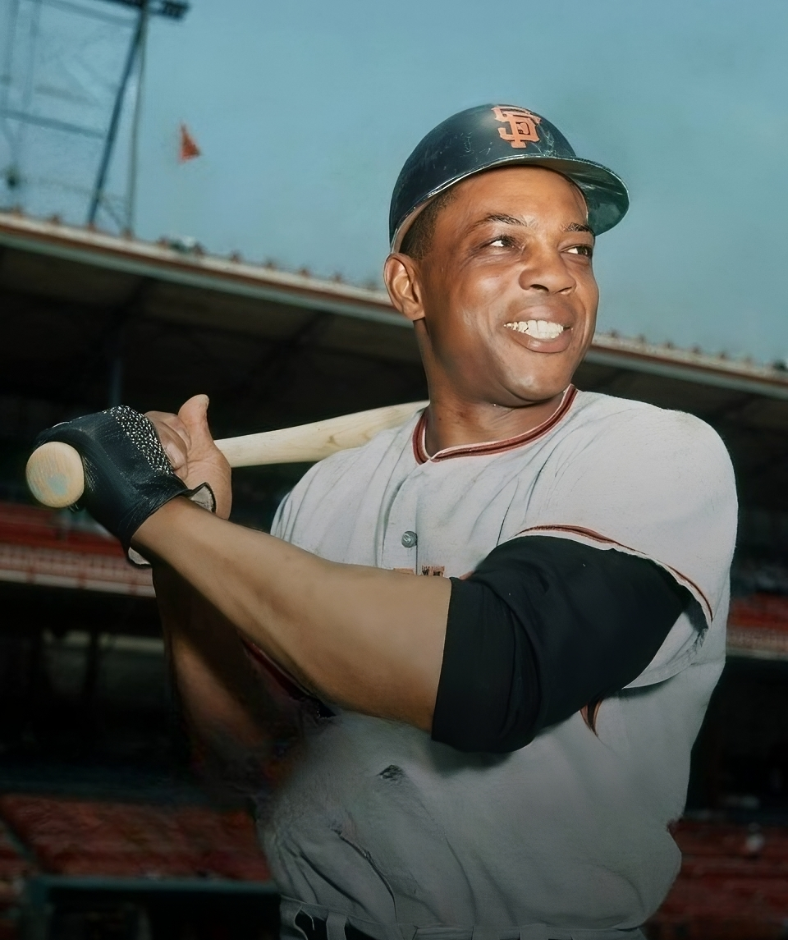Willie Mays, the “Say Hey Kid” of 1950s and 1960s Giants fame, a home run slugger and center field star for most of his 23-year Major League Baseball career, died Tuesday at 93 after a short illness, the San Francisco Giants announced.
Mays, almost inarguably the greatest living Hall of Famer, was to be honored Thursday evening when Major League Baseball stages a Giants-St.
Louis Cardinals game at Birmingham’s Rickwood Field, in Mays’ hometown and site of his Negro League career debut in 1948, one year after Jackie Robinson broke MLB’s color barrier. But Monday, he indicated he would not be able to make it and would enjoy the game from home.

Mays got 95% of the vote when he was elected into the Baseball Hall of Fame on the first ballot in 1979, after a career with 660 home runs (third all-time when he retired), 3,283 hits, two National League MVP awards and a record-tying 24 All-Star Game appearances (two games played each year from 1959-62). Mays’ All-Star Game records include most at-bats (75), most hits (23), most runs (20) and most stolen bases (six).
“His incredible achievements and statistics do not begin to describe the awe that came with watching Willie Mays dominate the game in every way imaginable,” Major League Baseball commissioner Rob Manfred said in a statement Tuesday night. “We will never forget this true Giant on and off the field. On behalf of Major League Baseball, I extend my deepest condolences to Willie’s family, his friends across our game, Giants fans everywhere, and his countless admirers across the world.
“Thursday’s game at historic Rickwood Field was designed to be a celebration of Willie Mays and his peers. With sadness in our hearts, it will now also serve as a national remembrance of an American who will forever remain on the short list of the most impactful individuals our great game has ever known.”
Follow every MLB game: Latest MLB scores, stats, schedules and standings.
Mays perhaps is best known for what is considered one of the greatest plays of all-time, his running basket catch in the 1954 World Series for the New York Giants against the Cleveland Indians.
It is known simply as “The Catch.” Mays called it, “The Throw.”
Game 1 was tied at 2-2 at the Polo Grounds in New York City when Vic Wertz hit a ball about 460 feet to dead center, appearing beyond Mays’ reach. Mays, running full speed, caught the ball over his shoulder and, in one motion, threw it back to the infield.
The Indians failed to score, and the Giants won the game on Dusty Rhodes’ pinch homer in the 10th inning, sweeping the Series for their first championship in 21 years.

“It was a wide-receiver catch,” Mays said. “I knew I’d get it. It was high enough where I could catch it. That wasn’t the problem. The hardest thing was getting it back to the infield.
“I knew Larry (Doby) could score (from second) if I didn’t get the ball back quickly. I scored lots of times from second base on a deep fly that was caught. That was the only thing I was worried about.”
The basket catch was Mays’ trademark, catching fly balls at his waist instead of over his head. He learned that style while playing baseball in the Army after being drafted in the early 1950s.
“I wanted to do something different than other guys playing the outfield,” Mays said. “When I came out of the Army, (manager) Leo (Durocher) said I could do it. ‘Just don’t drop it.’ I missed two. One in Pittsburgh, one in New York. Ten years apart. I was pretty polished.”
“They invented the All-Star Game for Willie Mays,” Hall of Famer Ted Williams once said.
Five-tool player
Mays won the 1954 NL MVP award in his first year back from the Army, hitting a league-leading .345 with 41 homers.
He was a five-tool player who played the game with exuberance. He was revered by the Giants’ organization and beloved by his adopted city, New York. He was photographed frequently in his younger days playing stickball with children in his Harlem neighborhood after he joined the New York Giants.
If Mays hadn’t missed nearly two full seasons in the Army or hadn’t played his San Francisco home games at windy Candlestick Park, longtime baseball observers believe he might have hit 800 homers.

Former San Francisco Giants great Willie Mays speaks at the ceremony to retire the number 25 of his godson, Barry Bonds, before a Major League Baseball game in 2018.
“I don’t like to look at it that way,” Mays once told the San Francisco Chronicle. “I like to look at it as, I had a good 20, 22 years. I had my time, and I enjoyed my time.”
His center field contemporaries stretched from the New York Yankees’ Joe DiMaggio, when Mays broke into the big leagues, to the Brooklyn Dodgers’ Duke Snider to the Yankees’ Mickey Mantle. Mays, Snider and Mantle became the inspiration for the 1981 song Willie, Mickey And The Duke, more commonly referred to as Talkin’ Baseball, by Terry Cashman.

Mays’ greatest idols, he said, were DiMaggio, Ted Williams, Stan Musial and Jackie Robinson.
“All you saw on the front page in my (Birmingham, Alabama) hometown was Joe and Ted and Stan,” Mays told the San Francisco Chronicle just before his 75th birthday.
“I wanted to pick which one I wanted to be like, and I picked Joe, because Joe was a more all-around ballplayer than the other two. Joe couldn’t hit like Ted and Stan, but he could do everything. I played the same kind of game.”
Mays learned to play the game from his father, Willie Sr., who was named after president William Howard Taft. Willie Mays Sr. played on all-Black teams in the segregated South. Father and son played together on a semi-pro steel mill team when the younger Mays was 14.
“Everybody knew him in Birmingham,” Mays said. “They called him ‘Cat’ because he could run like a cat, very quick. When I played with him, I played center, he played left. I said, ‘You play on the line, I’ll take care of everything else.’
“He followed me to New York and then to San Francisco. He wasn’t just my father. He was my friend. We could talk about anything, which was good for me.”
‘Say Hey Kid’ origin
Mays’ favorite keepsake from all his years in baseball, he said, was his 1951 scouting report when he played for Class AAA Minneapolis, where he hit .477 with eight homers and 30 RBI in 35 games.
“Everything that he does is sensational,” the report said. “(He) has made the most spectacular catches, runs and throws with the best of them. … Sensational negro boy is the outstanding player in Minneapolis club and probably in all minor leagues for that matter. … (He) hits to all fields and hits all pitches.”
Mays, when later asked to define his style, simply said: “When they throw the ball, I hit it. When they hit the ball, I catch it.”
He was assigned No. 24 in his first year with the Giants, and months later, got the nickname, “Say Hey Kid.”
“You see a guy, you say, ‘Hey, man. Say hey, man,’ ” Mays said. “Ted was the ‘Splinter.’ Joe was ‘Joltin’ Joe.’ Stan was ‘The Man.’
“I guess I hit a few home runs, and they said, there goes the ‘Say Hey Kid.’ “
Mays credited sportswriter Jimmy Cannon with the nickname, while others traced it to sportswriter Barney Kremenko.
Cannon created the nickname, he once said, because Mays didn’t know everybody’s names when he first arrived in the minors. Kremenko, then a writer for the New York Journal, referred to Mays as the “Say Hey Kid” after he overheard Mays say, “Say who,” “Say what,” “Say where,” “Say hey.”
The San Francisco city council established Willie Mays Day on May 24 of every year, celebrating the anniversary of his first day in the big leagues, May 24, 1951.
The Giants retired his uniform number, 24, in 1972 and the address of their home stadium, AT&T Ballpark, is 24 Willie Mays Plaza. His bronze statue in front of the main entrance is surrounded by 24 palm trees — and the right-field wall is 24 feet high.
In 2015, he received the Presidential Medal of Freedom from President Barack Obama.


